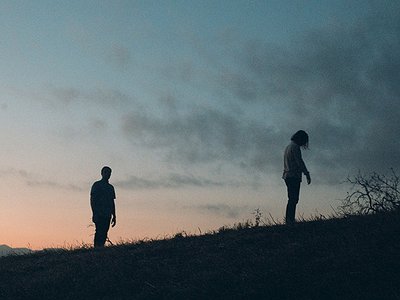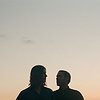Name: Balomorhea
Members: Rob Lowe, Michael Muller
Interviewee: Rob Lowe
Nationality: American
Occupation: Composers, Producers, Multi-Instrumentalists
Current Release: Clear Language on Western Vinyl
Recommendations: Daniel J. Boorstin’s The Image. This book, written in 1961 by Boorstin (who later became the 12th American Librarian of Congress) looks at what he calls “pseudo-events” and how they were changing Western and American culture in the mid-20th Century. It is dramatic to look back on his ideas about image making and see how deeply awash our society is in these pseudo-events; or as he says, the book is “about our arts of self-deception, how we hide reality from ourselves.”
John Wesley Installation, Chinati Foundation, Marfa, TX. Donald Judd’s stunningly beautiful/egomaniacal permanent installation compound in Marfa, TX is something every art lover should see, but my favorite room in the complex contains 13 paintings by the American painter John Wesley. Although they read as pop-art, the iconic structures and stunning colors give them a flatl contemporary sacredness unlike anything else I have seen. I could spend hours in that room.
Website / Contact: If you enjoyed this interview with Balmorhea, you can check out their replies to an earlier version of the 15 Questions here. More information about the band can be found on their website or facebook profile.
When did you start writing/producing music - and what or who were your early passions and influences? What what is about music and/or sound that drew you to it?
I began making my own musical expression sometime probably around the age of 15, but it wasn’t till around 19 or 20 that I was able to compose something cohesive that I wished to share with others. At that age my early passions and influences were all over the map and a bit disorienting, but once we formed the band Balmorhea my influences included Rachel’s, Max Richter, Eric Satie, and many others. Music has always been innate to me in that it is something that comes from within. It is something about it’s ability to express ideas or feelings without having to communicate anything explicit. It is a very mysterious language, but very affective.
For most artists, originality is first preceded by a phase of learning and, often, emulating others. What was this like for you? How would you describe your own development as an artist and the transition towards your own voice? What is the the relationship between copying, learning and your own creativity?
This is very true. In the early stages of writing music for Balmorhea we were very influenced by other artists we were interested in. Listening back to our earliest recordings I can hear that now. For me, my career as a musician has broadened every year. When I was young I was very interested in a certain type of music, a certain scene and a particular aesthetic. As I have grown older I would say that my musical horizons have broadened significantly to take in genres and types of music that I might have eschewed in my early years. To some extent it is a factor of time and input, the older you get the more you know of the world and the vast sea of art that preceded you.
What were your main compositional- and production-challenges in the beginning and how have they changed over time?
When Michael and I started making music we had very little knowledge about how to “properly” make a recording. Basically none at all. Se we set about making a record on our own using the most bare-bones tools available. In a way I am grateful that we started out that way because I think it allowed us to focus on the content of the music and not get distracted by the tools that can be available in the studio. As we continued to produce records we slowly were able to learn how to work in a studio setting, but I think our ignorant roots allowed us to continue to focus on the most important content, and that is the part of the song that you cannot describe in decibels or frequency ranges or expensive microphones.
What was your first studio like? How and for what reasons has your set-up evolved over the years and what are currently some of the most important pieces of gear for you?
Our first “studio” where we recorded our Self-Titled record was in Michael’s bedroom in his house in Central Austin. We recorded with two rented microphones into an early version of ProTools M-Box. We put a SM57 in the bathroom and recorded the water. We recorded the rain on the front porch. We tried to make things sound as natural as possible. It was so much more about the performance than the quality of the sound. Over the years we have grown and acquired many instruments and I would say that our most important “gear” is our instruments, my guitars and amps and keyboards. We are not super gear heavy musicians and I really like to work in studios with people who know how to engineer a sound rather than becoming an engineer.
How do you make use of technology? In terms of the feedback mechanism between technology and creativity, what do humans excel at, what do machines excel at?
In our early years we used technology very minimally. Almost all of our songs were worked out and arranged in a room live with other musicians and then taken into the studio as such. Now I would say we use recording technology to help in the compositional process. For our upcoming record ‘Clear Language’ we recorded demo versions of all of the tracks before we started work in the studio. In fact, we created over 40 songs and recorded various versions of them which allowed us to arrange things and look at the work we were generating as a whole and start subtracting from there. It was our first time to do that so I think that the technology definitely aided in our process as it allowed us to create such a detailed record and to return to ideas over time. I don’t think that machines excel at anything on their own except in aiding and magnifying what humans are already able to do. They can magnify our abilities and intuitions as well as help expand our abilities.
Production tools, from instruments to complex software environments, contribute to the compositional process. How does this manifest itself in your work? Can you describe the co-authorship between yourself and your tools?
In the scope of music and technology, we have a somewhat limited interaction with technology (although it touches everything we do). We basically use these tools as a crude studio setup, capturing sounds and rendering them workable on the screen. It allowed us to put disparate pieces next to one another and to scrap entire sections that had taken weeks to develop. We were able to catalogue everything. Outside of that, we use standard effects (delay, reverb, etc) in the compositional process. But ... we also like to think of spring-fed pools as our most inspiring software environments.
Collaborations can take on many forms. What role do they play in your approach and what are your preferred ways of engaging with other creatives through, for example, file sharing, jamming or just talking about ideas?
For this record, as mentioned above, we relied on crude recording technologies like voice memos as well as ProTools to capture and catalogue our ideas. Michael and I would each capture thoughts and passages and share them between one another. It’s not a novel approach, we just shared ideas and worked on them until we found what we were looking for. Ultimately what we are looking to communicate has very little to do with technology so in our process we are looking for ways for the technology to disappear.



